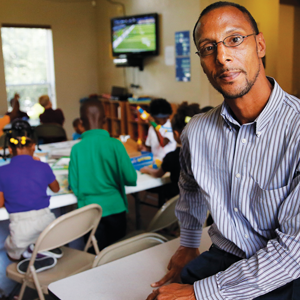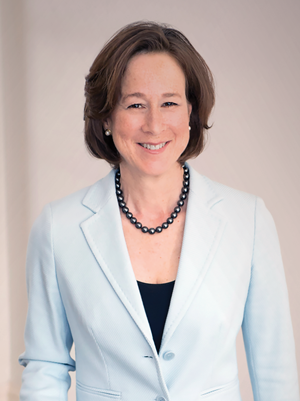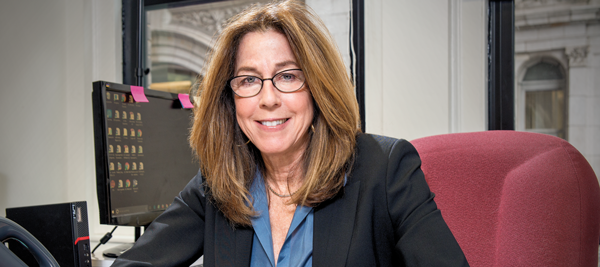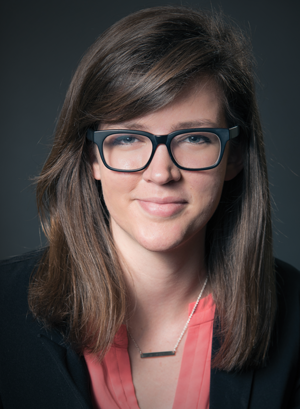States raising age for adult prosecution back to 18

Miguel Moll, who served time in adult prison as a teenager, co-founded Hyped About HYPE (Helping Young People Excel), an organization that speaks to kids in the juvenile justice system about making better choices. Associated Press.
Miguel Moll had a choice: Would he be a beast or a victim?
Moll was 17 when he was taken into custody on suspicion of joyriding. He’d been a passenger in a stolen car. It was exactly the kind of dumb thing teenagers do; but under Texas law, 17-year-olds are automatically prosecuted as adults. He was booked into Harris County Jail in Houston with adult offenders.
Moll, who remembers weighing about 120 pounds and standing about 5 feet 9 inches at the time, was being taken to a holding cell, when a big man ran up to the bars and yelled, “I got this one!” That’s when he made his choice.
“I became a beast just like them, in order to keep the other beasts off of me,” Moll, now 45, testified to the Texas state legislature in 2015. “What choices did I have? I either submit, bow down or fight back. And at 17 years old, these things stick with you.”
It stuck with Moll so well that he left jail with that “beast mentality”—and was quickly rearrested. This time, he ended up serving 19 years of a 20-year sentence for robbery in an adult prison. Testifying before the Texas legislature’s Juvenile Justice & Family Issues Committee, he said that because the adult system had no rehabilitation services—unlike juvenile detention, where those services are standard—he had to choose to reform himself.
Recalling it now, Moll says he realized less than halfway through his sentence that his tendency to fight with prison authorities, even when they were clearly abusing their power, could add time to his sentence. Rather than fighting with corrections officers, he says, he started fighting to change the culture of violence he saw.
“I was in there all those years, and I saw guys that were stuck in the same place where they [were when they] came in,” he says. “So I knew that if I wanted to avoid the revolving door, then I had to do something.”
Moll now works for Safe Hands Family and Children Programs, a Dallas-area nonprofit serving low-income families, and he is raising a son and working on a sociology degree. He also co-founded Hyped About HYPE (Helping Young People Excel), an organization that speaks to kids in the juvenile justice system about making better choices. He was speaking to the legislature on behalf of that group, along with three other men, in support of a bill intended to raise the age of adult jurisdiction in Texas to 18.
That bill—sponsored by Rep. Ruth Jones McClendon, D-San Antonio—failed, as did two similar bills. But increasingly, that makes Texas an outlier. Since 2009, seven states have raised the age of adult prosecution to 18, and five more tried during their 2015-2016 legislative sessions. In 2017, advocates are expecting “raise the age” bills in at least five states—more if you count proposals to increase the age to 21.

Dr. Judith Edersheim. Photo courtesy of Dr. Judith Edersheim.
These aren’t bleeding-heart liberal states; one of the early adopters was reliably conservative Mississippi. In fact, the juvenile justice reform movement is now bipartisan, with right-leaning organizations working with children’s rights advocates. They’re responding to studies showing that adult penalties lead to more teen recidivism, new science showing teenage brains really do mature later, and increasing political and financial pressure to address high incarceration rates.
Though not everyone is on board—law and order concerns and financial worries have stalled reform in some statehouses—advocates for juveniles say it’s definitely a trend.
“We’re at a critical time right now,” says Marcy Mistrett, CEO of the Campaign for Youth Justice, a Washington, D.C.-based national initiative focused on ending adult prosecution for juveniles. “We now have the fewest states left in history—seven—that define criminal responsibility younger than 18. I believe that this is a fight we can win.”
second chances
While Moll was learning the dubious lessons of adult prison, Charleston White was learning some very different things in Texas juvenile detention.
White wasn’t an obvious candidate for rehabilitation. At 14, he joined a group of teens who tried to rob a Foot Locker and ended up killing a man. Though White wasn’t the one who pulled the trigger, he was convicted of murder for his involvement. Testifying to the state legislature, he said he became a gang leader in juvenile detention. The state had the option to send him to adult prison when he turned 18, and he wanted to go. Growing up, he’d seen so many men from his community go to prison that he “literally believed that going to prison is what made you a man,” he said.
But four adult “house parents”—corrections officers who White says acted like parents to him—saw through White’s tough facade. He says they drove more than three hours to Fort Worth to tell a judge that White should stay in the juvenile system, risking their jobs in doing so.
Reflecting on it now, White says his attitude changed instantly.
“I wanted to go back and be accepted by my friends, because I feared their rejection, but I also now have something inside of me that’s pulling me in a different direction,” says White, who co-founded Hyped About HYPE with Moll. “Because I don’t want to disappoint these people. ... Now somebody finally believed in me other than my mother.”
And it’s a good thing they did because programs in juvenile detention helped him understand his own thoughts, feelings and actions and gave him empathy for others. None of those programs would have been available in adult prison. It made him, he says, who he is today—a juvenile justice and community activist who’s worked with the White House, a proud father and a student who hopes to eventually earn a law degree.
This kind of second chance was the original goal of juvenile justice. The first juvenile court was established in 1899 in Chicago by Progressive Era reformers who objected to the practice of putting kids in adult jails next to hardened criminals. They believed young people, if put through a system with more benign influences, could be rehabilitated.
Those juvenile systems had their ups and downs, but they met a serious challenge in the 1990s when crime rates rose and public concern grew about minors breaking the law. Over that decade, 45 states passed some kind of law that made it easier to try juveniles as adults, according to research from the John D. and Catherine T. MacArthur Foundation.
“It was a period of heightened moral panic,” says Laurie Garduque, director of justice reform at the foundation, which is wrapping up a 20-year program supporting juvenile justice research and reforms. “There was a sense that the juvenile justice system was not able to deal with these ‘more serious offenders’ [or] ‘superpredators,’ as they were labeled.”
But 20 years later, states are starting to rethink that. An important reason for that, child advocates say, is that the U.S. Supreme Court has led the way with a series of important decisions on juvenile justice. Beginning in 2005 and continuing up to the 2015-2016 term, the Supreme Court has held that it’s unconstitutional to execute people for crimes they committed as juveniles; outlawed automatic life without parole for nonhomicide crimes committed by juveniles; extended that ruling to homicide crimes; and, in 2016, made the ban on life sentences retroactive.
THE TEEN BRAIN DIFFERENCE
Marsha Levick, deputy director and chief counsel of the Juvenile Law Center in Philadelphia, says that helped start a conversation about how “kids are different.” And that conversation, she says, is partly because advances in behavioral and brain science show that adolescent brains really are different.
As Dr. Judith Edersheim, co-director of the Center for Law, Brain and Behavior at the Massachusetts General Hospital, explains it, there are three widely agreed-upon differences between adult brains and adolescent brains. One is that during adolescence, kids actually lose “gray matter,” the brain cells that do all of the brain’s computation. This “pruning” of gray matter is especially concentrated in the frontal lobes, which are responsible for self-control, planning, decision-making and other executive functions.
At the same time, Edersheim says, teenagers get more “white matter,” the cells that pass messages between parts of the brain, which increases processing speed. Scientists think these two changes make the brain more efficient, even though it also loses some computational ability. This process of brain maturation continues after the body matures; some scientists think it ends as late as age 25.
But perhaps the most conspicuous difference, Edersheim says, is that adolescent brains have more circulating dopamine—a neutrotransmitter that scientists believe governs rewards and learning—and more receptors in their brains to pick it up. Dopamine is released when a person receives many kinds of rewards, including new experiences, as well as things such as food and sex. This predisposes teenagers to seek out rewards and novelty.

Marsha Levick. Photograph by David Fonda.
The thinking, Edersheim says, is that this helps push adolescents out of the nest and into the world. And what kids learn during this process, she says, helps determine what parts of the gray matter get pruned. That means a kid’s environment matters a lot, and adult prison isn’t the best environment.
“If you don’t provide an adolescent with an opportunity to develop a social competency or self-esteem, if you don’t put them in contact with pro-social peers, then you’re setting trajectories which actually might persist through adulthood,” Edersheim says. “Adolescents are really these neurologic sponges for their environment.”
That’s the science that’s helping fuel the “kids are different” conversation Levick mentions. But at the same time, Levick says, that conversation is being driven by another discussion the country is having about justice reform generally. And that’s very much a bipartisan conversation.
“Conservatives were the ones who stepped forward most recently and said, ‘This is becoming fiscally irresponsible, to take what are now increasingly limited public resources and ... lock up a population that doesn’t really pose a safety risk,’ ” says Levick, who co-founded the Juvenile Law Center in 1975. “And I think once conservatives began putting that message out there, liberals and progressives were more than happy to join in.”
Dianna Muldrow, a policy analyst at the conservative policy organization Right on Crime, says it’s about more than money—it’s about creating better outcomes, for society as well as for teenagers. Three decades of research have consistently shown higher recidivism rates for teenagers sent to adult prison. For example, a 2007 review of studies by the Centers for Disease Control and Prevention found that the kids who served time in adult prison were 34 percent more likely to commit new crimes than similar kids who went to juvenile detention.
Outcomes for the kids themselves are also bad. According to the Campaign for Youth Justice, which used Department of Justice and CDC numbers, teens under 18 being held in adult jails are 19 times more likely to commit suicide than teens generally, and 36 times more likely than those held in juvenile facilities. The Bureau of Justice Statistics says youths under 18 were 21 percent of those sexually assaulted in adult jails in 2005, despite being only 1 percent of jail inmates that year.
Muldrow also notes that when teens are treated as adults, there’s no requirement for the police to notify the parents. Treating kids as kids helps keep their parents involved.
Read the sidebar: Kids in Chains
In some facilities, sexual assault is addressed by putting the youngest inmates in solitary confinement—a practice that quickly and catastrophically hurts their mental health, driving up suicide rates. In 2016, President Barack Obama banned solitary confinement for juveniles in federal prison, saying it’s overused and can have devastating, lifelong consequences. And these are kids who often already have problems. Kids who get in legal trouble have disproportionately suffered abuse, neglect or another trauma. A DOJ study found that 50 to 70 percent have behavioral health diagnoses.
And kids of color make up a disproportionate number of those treated as adults, reflecting a racial disparity trend in other parts of the criminal justice system. The Campaign for Youth Justice says black adolescents are nine times more likely to be sentenced as adults compared to their white contemporaries; Latino juveniles are 40 percent more likely; and American Indian youths are nearly twice as likely. A federally funded 2007 study of juvenile justice in three cities said that while some of this can be explained by nonracial risk factors—such as family income, the age of the mother at the time of her first birth and education problems—that didn’t entirely eliminate the disproportionate numbers.
Garduque says much of the behavioral research was already available in the 1990s, when states were passing laws that treated teenagers more like adults. But nobody had set out the legal implications of that research, she says, which was part of why the MacArthur Foundation spent two decades funding that kind of work. And the Supreme Court rulings, which relied in part on MacArthur-funded research, set the precedent.
“This idea that children are different for the purposes of criminal punishment has now become a powerful constitutional principle,” Garduque says.
‘Is Your Son’s Life Worth It?’
In 2005, a tragedy spurred Connecticut to become one of the first states to put that principle into practice. That was the year David Burgos, 17, committed suicide in an adult prison.
Burgos’ mother, Diana Gonzalez, was initially pleased when her son went back to prison. At least he’d be off the streets, she reasoned. Burgos had been homeless off and on, and she worried about his safety.

Dianna Muldrow
Being homeless was just the beginning of the story for the teenager, who had been in and out of Connecticut state institutions since he was 10. Abused as a child and diagnosed with bipolar disorder, he had so many episodes of violence, toward himself and others, that Gonzalez asked the state for help. But when Burgos was placed in group homes or shelters, he frequently ran away, occasionally showing up at relatives’ houses for showers and meals. When he got into a physical fight with his older brother, he was convicted on a weapons charge.
One condition of Burgos’ probation on that charge was that he accept child welfare services. But he refused—so he was sent back to prison. And because Connecticut automatically prosecuted 16- and 17-year-olds as adults then, he went to a facility run by the adult corrections system to await trial. That’s where, in the summer of 2005, he hanged himself with a bed sheet.
The suicide jump-started a conversation about age for juvenile jurisdiction. A raise-the-age bill had just failed in the state legislature, and Abby Anderson, executive director of the Connecticut Juvenile Justice Alliance, says she had met with the Campaign for Youth Justice about launching an effort. Days after the death, four state agencies began investigations, and then-Gov. M. Jodi Rell called for the state to study raising the age.
Anderson says that child advocates “went into full-court press.” Supporters in the state legislature created a study group in 2006 to look at the details of implementing Raise the Age, as it became known. On the study group’s recommendation, legislation was introduced in 2007 to raise the age of adult prosecution to 18 in 2010.
Getting that passed was much harder, Anderson says. Police agencies were particularly concerned about the practical implications of treating teenagers as juveniles instead of adults, such as the added time required for parental noti-fication when an arrest is made. Some said they’d need entirely new facilities to house arrested teens separately from adults.
Others objected that raising the age would hurt public safety by letting dangerous delinquents loose on the streets. But Connecticut, like most states, had a separate provision permitting juveniles to be tried in adult court for certain serious crimes. (Some states also permit this at the discretion of a judge or prosecutor.) Anderson says once people learned that, their resistance to Raise the Age often disappeared.
But a bigger concern was the financial cost. Anderson says it genuinely costs more to put people through the juvenile justice system than adult prison because kids in the juvenile system are getting education, therapy and other rehabilitation services. Those are pricey, but they’re also the reason recidivism for juvenile detainees is lower, Anderson notes. To proponents, raising the age was a priority worth the money.
That argument got a powerful boost from Gonzalez, the mother of David Burgos, when she testified before the state legislature in 2006. “She was like, ‘Basically, what you’re saying is my son’s life isn’t worth it. Is your son’s life worth it?’ ” recalls Anderson. “And that was a real crucial turning point in the effort, because it became very hard after that for a legislator to say publicly [that] this is just about the money.”
The bill passed—and survived the recession of 2007-2009, which Anderson says made the cost concerns “a lot more real.” Under pressure from opponents, who kept introducing legislation to repeal it entirely, Raise the Age proponents agreed to split implementation across two budget cycles. Connec-ticut’s 16-year-olds would begin to be prosecuted as juveniles on the original implementation date, Jan. 1, 2010. For 17-year-olds, implementation would be pushed back to July 1, 2012. Even with that, Anderson says, “it was a nail-biter to the very end.”
But when January of 2010 rolled around, a funny thing happened: nothing. The size of the juvenile justice system didn’t double, as some had predicted. It actually shrank a bit, Anderson says, partly because crime was down and partly because of companion bills to Raise the Age provided alternatives to detention. When it was time to include the 17-year-olds, Anderson says there wasn’t much discussion.
And for Connecticut, the results of Raise the Age have been good. Juvenile crime is still trending down, and spending on juvenile justice in 2011-2012 was slightly lower than it had been 10 years earlier. The Connecticut Judicial Branch says 16- and 17-year-olds are actually less likely than younger juveniles to be rearrested during probation. There are far fewer juveniles in adult prison (where they can still go if a judge permits it). And the Connecticut Office of Policy and Management says the number of young adults 18-20 in adult prison is also down, which it says indicates the success of rehabilitation in the juvenile system.
Similar arguments are likely to play out in at least five states during the 2017 legislative session: Missouri, New York, North Carolina, Texas and Wisconsin. Advocates say public safety concerns have killed reform in at least two of those states—New York and North Carolina—in recent years.
But in other states, the primary impediment is the cost. That includes Texas, where cost was the killer in the last legislative session, according to Elizabeth Henneke, a policy attorney focusing on juvenile justice at the Texas Criminal Justice Coalition.
“Even last session, there was a wide acceptance that raising the age was the best thing for Texas children,” says Henneke. “The question has just been the financial piece. And really, the pushback then has not even been on whether or not to fund it; it’s just a question of how to fund it and what that looks like.”
AN Arbitrary Line
When Vincent Schiraldi became commissioner of probation for New York City, he had an office inside a Brooklyn courthouse. There, he got to see teenagers parading in and out of court all day.
“They kind of fall asleep with their earbuds in until somebody barks their name at them,” says Schiraldi, now a senior research fellow directing the Program in Criminal Justice Policy and Management at the Harvard Kennedy School. “They go up, they get yelled at by the prosecutor, they get lectured by the judge, their defense attorney says something incomprehensible to them, and for the most part they go home no better off and a little more alienated from us adults than when they came in.
“But not to worry, because they’re going to be back pretty soon.”
Schiraldi should know—he’s one of the nation’s most prominent advocates for reforming juvenile justice. Off the top of his head, he can tell you that young adults have a 78 percent rearrest rate over three years, and he can tell you about the brain science that helps explain why. The same neuroimaging studies that show important structural differences between adolescent and adult brains show that those differences don’t disappear until well into people’s 20s. That is, brain maturation lags behind body maturation—and well behind the age of adult prosecution in many states.
When he arrived as commissioner of probation, directly after he headed the Washington, D.C., juvenile justice agency, Schiraldi began thinking about these factors. The agency supervised young adults up to age 21. In New York, kids as young as 13 were on his adult probation caseload, waived into adult court for serious offenses. “It became pretty apparent, the arbitrary nature of the dividing line between adults and juveniles,” he says.
During his time in New York—first as probation commissioner and then as a senior adviser to Mayor Bill de Blasio’s Office of Criminal Justice, Schiraldi made friends with Jeff Butts, a professor in the criminal justice department at the John Jay College of Criminal Justice, who convinced him that maturation is a process. Kids don’t wake up fully mature on their 18th birthdays, Schiraldi recalls Butts saying, and the justice system should reflect that.
As Schiraldi got deeper into the subject—speaking, researching and even becoming part of a delegation that observed a juvenile prison in the German countryside—he started to believe that the legal system should reflect the more gradual maturation people really undergo.
That’s how Schiraldi became a proponent of prosecuting young adults as juveniles up until at least age 21, or otherwise treating them as a different class of defendants—a radical idea in a country where 17-year-olds are routinely prosecuted as adults. In September of 2015, he laid out a case for that idea in a paper published with two Kennedy School colleagues, Bruce Western and Kendra Bradner.
To support their argument, the authors invoke some of the same research used by proponents of raising the age to 18. But they also argue that today’s young adults are much more like adolescents, sociologically, than they were a few generations ago.
Take marriage, Schiraldi says. In 1960, according to the Pew Research Center, 45 percent of people ages 18 to 24 were married. In 2010, that rate was 9 percent.
The same is true of work, Schiraldi says. As an example, he offers his own childhood neighborhood: the Greenpoint section of Brooklyn. When he finished high school there in the 1970s, graduates could easily get a factory job or an entry-level finance job without a college degree. With that salary, they could soon buy or rent a home and start raising a family.
None of that is true today, and criminologists have found that steady work and marriage are two important predictors of whether someone will obey the law. Without that stability, young adults, who are already disproportionately risk-takers, are even more likely to get in trouble. Unfortunately, the criminal justice system doesn’t take that into account.
And that’s why Schiraldi believes raising the age past 18 should be on the table, along with other developmentally appropriate options.
beyond legislation
Thus far, three states have considered the idea. In the 2016 legislative session, bills to raise the age to 21 failed in both Connecticut and Illinois; Vermont also considered one, but decided to study the idea first. Schiraldi thinks it’s still a live issue in those jurisdictions. It’s been a priority for Connecticut Gov. Dannel Malloy.
There are other options for addressing the needs of young adults, Schiraldi says; the cities of New York and San Francisco have added some protections for young adults on a piecemeal basis, he notes.
“Whatever the solution might be—changing the adult system, creating a third system or including young adults in the juvenile system—we need to fix that,” he says. “Because it’s resulting in some very, very bad outcomes. For the kids and for us.”
Hyped about HYPE co-founder White might agree with that. He draws an analogy to the fighting dogs that were kept by NFL quarterback Michael Vick, almost all of which were eventually rehabilitated and adopted by families into caring homes.
“We nurtured and we loved those dogs back into their original state of nature,” White says. “And those dogs are no longer fighting and killing other dogs. If we can do that for animals, why can’t we do that for our children?”
This article originally appeared in the February 2017 issue of the ABA Journal with this headline: "Age Appropriate: Fueled by new research and bipartisan interest in criminal justice reform, states are raising the age for adult prosecution back to 18."



